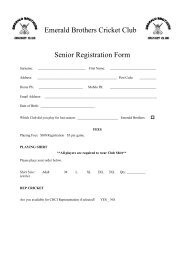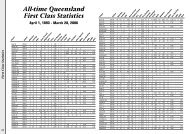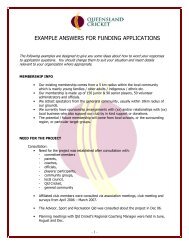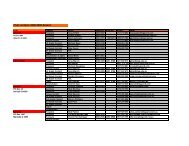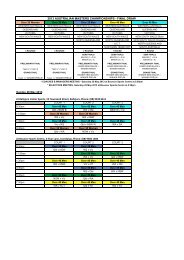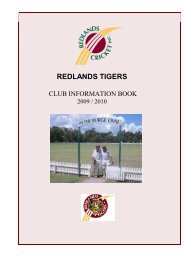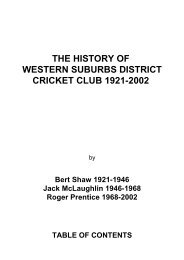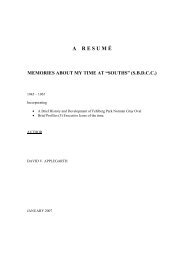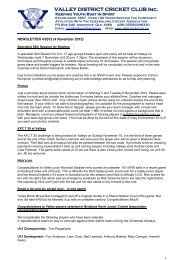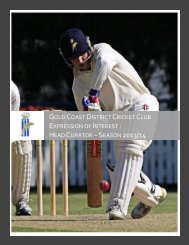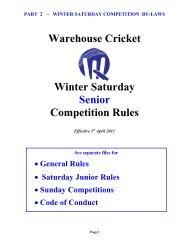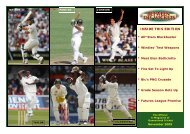2012 - 2013 PREMIER GR ADE HANDBOOK - Queensland Cricket
2012 - 2013 PREMIER GR ADE HANDBOOK - Queensland Cricket
2012 - 2013 PREMIER GR ADE HANDBOOK - Queensland Cricket
Create successful ePaper yourself
Turn your PDF publications into a flip-book with our unique Google optimized e-Paper software.
6.3 In matches where both teams have had the opportunity of batting for the same number of overs, and in<br />
matches where the application of slow play penalties under Playing Conditions 4.4.1 and/or 4.4.2 is the<br />
only reason for a difference in the number of overs each side has had the opportunity to face, the team<br />
scoring the higher number of runs is the winner.<br />
If the scores are equal, the result is a tie and no account will be taken of the number of wickets lost by<br />
either side.<br />
If the number of overs for the team batting second has to be curtailed to fewer than that for the team<br />
batting first by circumstances other than slow play penalties, the match will be decided on run rate from<br />
balls or overs and part overs received [fractions to be ignored].<br />
Example 1: Team batting first receives 20 overs, and scores 100 runs = run rate of 5.00. Team<br />
batting second receives 15 overs and must score 76 runs to win.<br />
(15 x 5 + 1 = 76)<br />
Example 2: Team batting first receives 15 overs and scores 60 runs = run rate of 4.00. Team batting<br />
second receives 12.3 overs and must score 51 runs to win.<br />
(12.5 x 4 + 1 = 51)<br />
If a team is dismissed in fewer than its allotted overs, it shall be deemed to have received all of its<br />
allotted overs for the purpose of calculating run rate.<br />
6.4 If a penalty for slow play is invoked under the provisions of Playing Condition 4.4.1 or 4.4.2, the<br />
number of overs that each team is deemed to have received will be the number of overs which would<br />
have been received if no penalties had been applied to that team, for the purposes of calculating run<br />
rate. (eg. Team A bats 20 overs, but is only required to bowl 19 to team B who have been penalised one<br />
over for slow play. Team A bowls even more slowly than Team B, and at the end of time has only<br />
bowled 17 overs. Team A is thus penalised 2 overs since Team B has up to 21 overs to score the<br />
necessary runs for victory. Team A is deemed to have received 20 overs, and Team B is deemed to<br />
have received 19 overs for the purpose of calculating run rate)<br />
7. WIDE BALLS AND NO BALLS<br />
7.1 Any off side delivery, which in the opinion of the umpire does not give the batter a reasonable<br />
opportunity to score shall be called a Wide. As a guide, a delivery passing the striker on the leg side,<br />
more than 1ft (30.48cm), from the middle stump without any contact with the striker’s bat or person<br />
shall be a Wide unless the ball passes between the striker and the stumps. Lines shall be drawn from<br />
the popping crease to the bowling crease, parallel with the return crease, measured 1ft (30.48cm) from<br />
the middle stump on both sides of the wicket.<br />
7.2 Although Regulation 28 does apply with regards to the bowling of full high pitched balls the<br />
application of this Regulation when in the opinion of the umpire the ball is not considered dangerous,<br />
the ball shall still be called No Ball, however it will be at the umpires discretion that the bowler be<br />
removed.<br />
8. FIELD RESTRICTIONS<br />
8.1 Two semi-circles shall be drawn on the field of play with a radius of 23 metres from the middle stump<br />
at either end of the pitch. The ends of each semi-circle shall be joined to the other by a straight line<br />
drawn on the field on the same side of the pitch.<br />
8.2 At the instant of delivery, there may be no more than five fielders on the leg side.<br />
8.3 For the first 6 overs of each innings in a Twenty20 match, or for the first 10 overs of a 35 over match,<br />
only two fielders are permitted to be outside the field restriction marking at the instant of delivery. For<br />
the remaining overs, only five fielders are permitted to be outside the field restriction marking at the<br />
instant of delivery.<br />
8.4 In the event of an infringement of Playing Conditions 8.2 or 8.3 above, either umpire shall call and<br />
signal NO BALL.<br />
8.5 When play is delayed or interrupted and the total number of overs available is reduced, the number of<br />
overs in regard to field restrictions outlined above shall be reduced as detailed below.<br />
8.5.1 Where both teams are scheduled to receive the same number of overs, the field restrictions<br />
shall apply equally for both teams, and the number of overs for which field restrictions shall<br />
apply shall be reduced in proportion to the number of overs scheduled to be bowled. (The<br />
calculation shall be the scheduled number of overs multiplied by 0.3); and<br />
55



